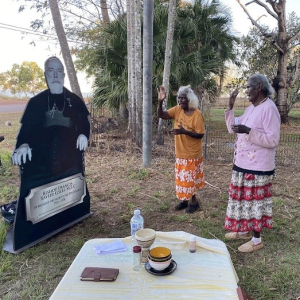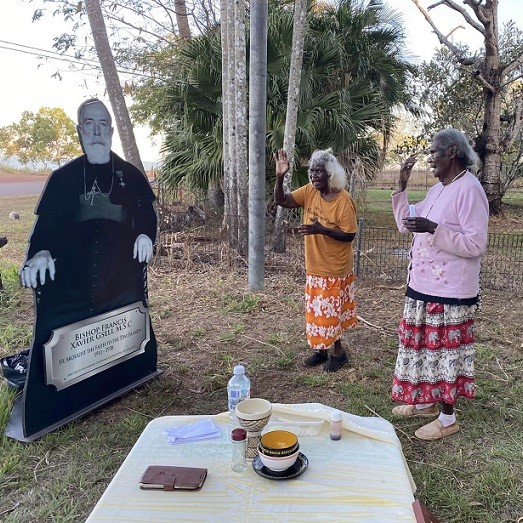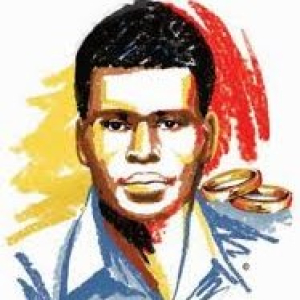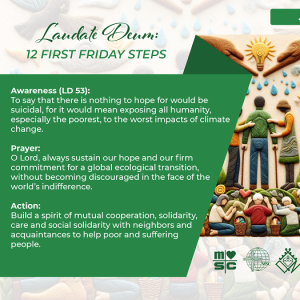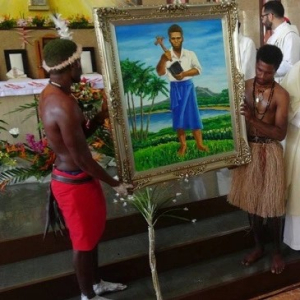Peter MALONE
Totem/ 2023
TOTEM
Mexico, 2023, 95 minutes, Colour.
Naima Senties, Montserrat Maranon, Marisol Gase, Saori Gurza, Matteo Garcia, Teresa Sanchez.
Directed by Lila Aviles.
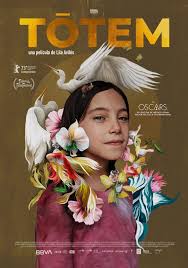
An engaging film full of humanity. It was the winner of the Ecumenical Prize (from a combined Catholic and Protestant Churches’ Jury) at the Berlin film Festival, 2023.
This is a Mexican film, written and directed by Lila Aviles with great sensitivity. The principal appeal is that the main focus is on a seven-year-old, Sol (short for Solecito). She is played so well by Naima Senties. We spend much of the film watching her, so expressive, so full of life, moments of happiness, moments of sadness, which means that we watch the adult world through her eyes.
Sol has a young mother, enjoys being with her mother, joking, making wishes – especially a wish that her father would not die. And this means that there is an air of melancholy underlying the good humour of the film. Tona, her father, has terminal cancer, is cared for at home by a maternal nurse, supported by his sisters and their children, and his elderly therapist father who needs an electro-larynx to speak and communicate and who spends his spare time with bonsai tree art.
In fact, the action of Totem takes place over a couple of hours. The plan is to hold a birthday party for Tona, one sister, Nuri, cooking, baking and decorating the birthday cake, wonderfully caring for her little daughter, Esther, who can be full of pleasant mischief, but also drinking. The other sister, Alejandra, with two older children, is bossiness personified, even spending much needed money for Tona’s medical care, to invite in a woman who will go through rituals to cast out any evil powers.
We get to know so many of the members of the family rather well, liking some, wary of others. But, all the time, we are with Sol, wanting to see her father but his not being ready, so frail, struggling at times to walk, needing constant attention. When, eventually, she goes in to see her father with her mother, there is such joy for all of them.
Sol is an intelligent little girl, able to comment on adult themes about how the world ticks. She knows about birds (and her father gives her a beautiful gift of a large painting of her favourite birds), she plays with the insects, snails and ants, is observant.
Then the guests arrive for the party, so many of Tona’s friends from school days, extended family, Latin American party full of verve. There are some performances, some joking, and a wonderful scene where Sol is on her mother’s shoulders, a large cloak concealing her mother and Sol lip syncing and gesturing to an operatic aria – to the delight of all at the party and to the cinema audience.
While the film is something of a joyous hymn to life, it faces squarely the realities of illness and death. And we, the audience, respond to both but our awareness enhanced by our liking for and our sympathies with Sol and her childlike responses.
- Mexican life? The middle class? Families, friends, the party, illness and death?
- The Mexican settings, the opening in the toilet, driving the car, under the bridge and the wishes, arriving at the? The house, the rooms? The kitchen? Tona and his room? The celebration of the party? The musical score?
- Sol and her mother, the toilet intimacy, under the bridge, the wishes, Sol wishing her father not to die? Sol, at seven, the bond with her mother, the love for her father, close-ups, her perspective on everything and everyone, the audience sharing it, charmed by her, interpreting people and events through her?
- The household, the house, the rooms and corridors, the kitchen, common rooms, the outside for the party? And his illness, his room, his weakness, Cruz and her care for him, gentle, and not being paid on time, salvaging his paintings and smuggling them out? His struggles, walking, shower, getting dressed? Constant care?
- The household, the sisters, Nuri, short hair, severe, yet loving with Esther, her treatment of her? Doing the shopping, banking the cake, the fire? Her drinking? Awkwardness, not going to the party, staying in the kitchen?
- Alejandra, husband, the kids, the phones, getting them to work, cleaning the carpet? Her bossing us? Getting the woman to cleanse the house? Using the funds Tona’s health? Getting the work done, organising, the clash with her sister, their fighting?
- Sol’s mother, the theatre, her look, the nose ring, arriving, going to see Tona, Sol and her joy, the painting of all the birds, her explanations for her father, the embraces, happiness? Her gift and his response?
- The father, age, loss of voice, electro-larynx to communicate, the therapy session? His working with the bonsai, trimming the trees? His talk with his son, working on the tree for years, the gift to his son? His retreat?
- The crowd arriving, the elderly couple and the session with the visitor, the psychic communion? The friends from school days, extended family?
- The joy of the party, Tona eventually arriving, his having to go back, toilet, but his joy with the crowd, their acclaim, their happy memories, his winning the contest at school as the most handsome?
- The performances, the singing and dancing, the speeches? Sol, the preparation with her mother, on her mother’s shoulders, the cloak covering the mother, lip syncing, the gestures, everyone enjoying the performance?
- The audience being with Sol, her play, with Esther, with the aunts, playing with the snails, on the picture, the ants, her knowledge, the question about the end of the world, her father’s gift and her being with him? Her observing the guests?
- The finale, indication of death, acceptance of death, the credits glimpse and the aftermath, the empty bed, the scorpion…?
Memories for Chevalier Family who worked In the Tiwi Islands, NAIDOC Week
Memories for Chevalier Family who worked In the Tiwi Islands, NAIDOC Week
Our Lady of Peace and St. Therese - Wurrumiyanga, Tiwi Islands: 113th Anniversary of the First Mass Celebrated by Bishop Francis Gsell in Tiwi Islands. (Story and photos from the parish Facebook page.)
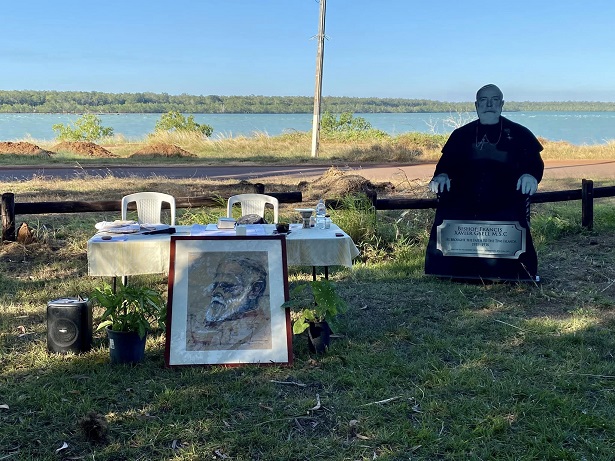
Today we celebrated the 113th anniversary of the first Mass celebrated by Bishop Francis Gsell on Bathurst Island. Fr. Gsell moved to the island in 1911 to establish a mission among the Tiwi people. On 8th June 1911 he celebrated first Holy Mass at Tiwi islands. The OLSH Sisters arrived in 1914 to open a school, and soon, the children agreed to be baptized, forming the core of the Christian community. Fr. Gsell dedicated 27 years of his life to the mission on Bathurst Island (Nguiu).
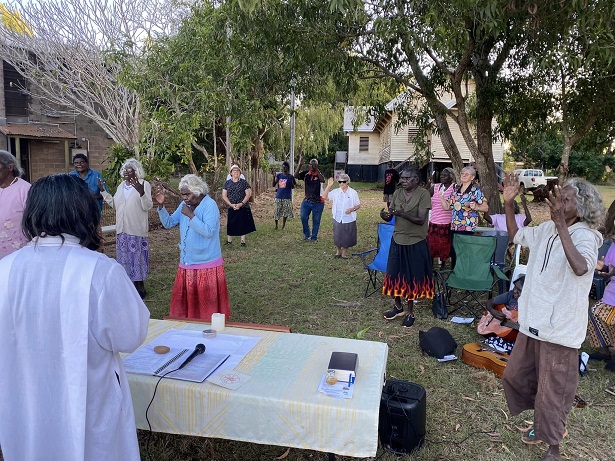
As an apostolic administrator, Fr. Gsell extended the Catholic presence to Alice Springs in 1929, Tennant Creek (Santa Teresa Mission and Charles Creek) in 1936, Port Keats (Wadeye) in 1935, and Arltunga in 1943. At age 66, Fr. Gsell became the Bishop of Darwin (1938-1948), overseeing a vicariate that stretched as far as Torres Strait. He ran the diocese from Alice Springs.

Upon his retirement in 1949, he moved to the MSC monastery in Kensington, Sydney, where he prepared his memoirs, published in 1956 under the title "The Bishop with One Hundred and Fifty Wives" (Angus and Robertson, London).

Bishop Gsell died on 12 July 1960. He was initially buried at St. Mary’s Towers in Douglas Park, but in 1982, his remains were transferred to the crypt of St. Mary’s Cathedral in Darwin. An Aboriginal hostel in Nightcliff (Darwin) is named after him, and in August 2006, a lavish commemoration of Gsell’s arrival in Darwin took place, featuring a centenary Mass and a reception at Parliament House.
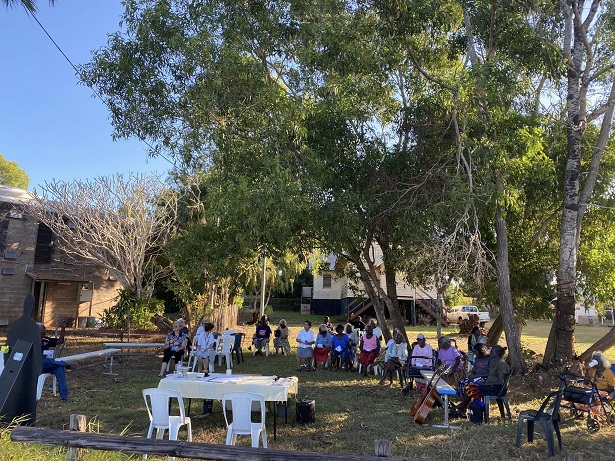
Bishop Gsell is rightly called “The Apostle of the Tiwi.” He received the Tiwi name 'Patakijiyali'. Today, we are grateful to remember him on the 113th anniversary of his first Mass on the Tiwi Islands on June 8, 1911. We celebrated a Holy Mass in his memory, experiencing the joy of that first Mass. Our Tiwi people even sang a song dedicated to Fr. Gsell:
“Ngini yipirranyuwinayi ngawa amini Patakijiyali
Yinimarruwariyi pupuni ngirramini ngini ngarra Ngawa-rringani
Nginja nguwuri, aya Amini
Ngajingawula ngumpungunyukuruwarni
Pili nginja warntirana, nginja mijuwalini”

During the Holy Mass, we offered our prayers for Fr. Gsell and all the Missionaries of the Sacred Heart (MSC), the Daughters of Our Lady of the Sacred Heart (OLSH), and for all missionaries and lay missionaries.
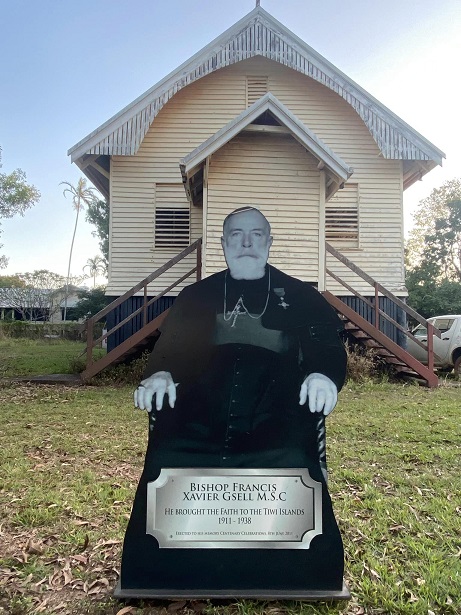
Birdeater
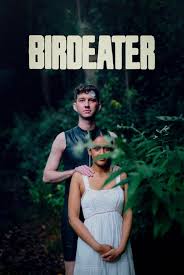
BIRDEATER
Australia, 2023, 113 minutes, Colour.
Mackenzie Fearnley, Shabana Azeez, Ben Hunter, Jack Bannister, Clementine Anderson, Alfie Gledhill, Holly Wilson, Carolyn McQuade.
Directed by Jack Clark, Jim Weir.
Birdeater is a first feature film by Jack Clark and Jim Weir, story by Clark, the writing the screenplay together and directing together. The film has received quite some acclaim from festivals, in the United States, Best Narrative feature at the Sydney film Festival, 2023.
There is a clue early in the film for audiences who notice posters on walls. The poster is for the 1971 film, Wake in Fright, set in Broken Hill, story of aggressive men, bonding, drinking, kangaroo hunts… And, the question of many about the title – and the suggestion of birds attacking birds, predators.
This is a story of men and their treatment of women. Three of the central male characters were at school together, aspects of privilege in that background. The main focus is on Louis (Mackenzie Fearnley) seen initially at the beach gazing at a young woman, Irene (Shabana Azeez). Then we see them together, living together, her suffering from anxiety, on medication, he solicitous about her, their love for each other. And he proposes a Bucks’ party, planning with his friend Murph to officiate at a wedding ceremony during the party. He invites Irene to come, she at first reluctant, consenting.
The main part of the film focuses on the party itself and the behaviour of each character. It is interesting to note that in the many articles and reviews about this film, everyone uses the word “toxicity”, “masculine toxicity”. The clue from Wake in Fright is significant.
Charley is another friend of Louis from school days. He comes with his partner, Grace, both of them with a Christian perspective. There is an unexpected guest, Sam, a friend of Irene, not quite fitting into the group but participating in the party.
But the most significant guest is Dylan (Ben Hunter), friend from school, living a wild kind of life, recently travelling in Mexico. He is macho, aggressive, expectations of the party, surprised at the women being there, putting pressure on Louis, forcing him to drink, making a speech which starts with praise and then degenerates into an attack, forcing them to play a game, Paranoia, which targets Louis.
There is drinking, there are drugs, and move into strange memories of the past, and some hallucinatory experience, especially for Louis. And, out in the bush, there is a stripper with her chaperone, taunting the men – especially Charley and the repercussions for him.
Sequences are quite vivid but it is over to the audience to piece them all together, the chronology, the reality and the fantasy, evaluate how the men treat the women, Louis’ treatment of Irene, the relationship between Charley and Grace, the dominance of the men, their presumptions, expressions of love but also behaviour of control, psychological violence.
Birdeater is meant to be provocative and it is, meant to be uncomfortable a challenge for the audience to test its own attitudes, especially about current behaviour and masculinity and power.
- The title, suggestion of birds of prey? Predators?
- The Australian setting, universal themes? The city, the beach, apartments, countryside, the river the fairy, the setting for the party? The musical score?
- Comments that the film attacks “masculine toxicity”? The men, their age, backgrounds, education, styles? Attitude towards women? Exercises of power? The Bucks’ party, behaviour, drinking, interactions, secrets, revelations?
- The different time periods, the opening with Louis and his seeing Irene? The relationship, time together? The plan for the wedding? The party, the invitations? The behaviour at the party, drugs, hallucinations, memories, the audience putting the pieces together?
- Louis and Irene, her being British, the Visa issue, marriage? Louis, his life, the scar on the side of his face (and the later visuals of his being run down)? The attraction to Irene, the living together, her anxiety, medication, the love, his going out, her being sedated, his being with his friends – and the Betty Boop cartoon? The plan for the party, inviting Irene, asking Grace to come to support Irene?
- Irene, her personality, relationship with Louis, her past, British, her anxiety, medication? Wary about the party, travelling with Louis?
- Charlie and Grace, together, Christian background, Grace and their attitude to the party, knowing everyone, interactions with them, support of Irene? The issue of drugs? Charlie and his friendship with Louis, from school days, his behaviour at the party?
- Murph, friendship with Louis, his wedding licence, the plan for the marriage? His behaviour at the party?
- Dylan, on the road, the breakdown, his appearance, manner, the past in school, his travels to Mexico, a wanderer, the relationship with Louis, at the party, wanting to force the beer on Louis, his behaviour, a touch feral, his speech the party, benign start, aggressive ending, playing the Paranoia game, tossing the coin, cheating, questions and answers? Drinking?
- Sam, knowing Irene, the relationship between them, an outsider, participation in the party?
- The atmosphere and the drinking, the drugs, the driving, going out to the countryside, the stripper and her caravan and protector, the taunts, the effect on Charlie, becoming him? His protesting that he had been a virgin, the issue of rape, Dylan’s sister? His shame, driving away with Grace, confessing, the beginning again?
- Dylan, in the countryside, the stripper, the return, talking with Murph, Murph and his behaviour during the party, the drugs, sexuality? Lift from Dylan, Dylan abandoning him?
- The morning after, Louise experiences during the night, memories, hallucinations, memories of meeting with Irene, the accusations she was drunk, targeting her? The drive, his being knocked down, his injuries? The consequences for his relationship with Irene?
- The driving away, her sleeping, the issue of the medication, his putting it in the bottle of water, the ferry, his going to the toilet, the keys in the car, the ferry arriving – and the film ending? What might happen?
Horizon. An American Saga. Chapter 1
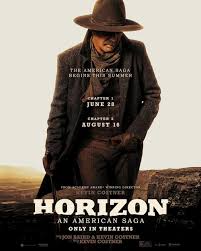
HORIZON. AN AMERICAN SAGA, CHAPTER 1
US, 2024, 181 minutes, Colour.
Kevin Costner, Sienna Miller, Sam Worthington, Jena Malone, Michael Rooker, Danny Huston, Owen Crew Shoe, tatanka Means, Ella Hunt, Tim Guinee, Giovanni Ribisi, Scott Haze, Tom Payne, Abby Lee, Will Patton, Jim Lau , Georgia McPhail, Luke Wilson, Angus McFadyen, Isabelle Fuhrman, Hayes Costner, Michael Angarano, Jeff Fahey, Dale Dickey, Jamie Campbell Bower, David O'Hara and James Russo.
Directed by Kevin Costner.
Kevin Costner has had a long screen career, over 40 years, winning an Oscar for Best Director in 1994 Dances with wolves. Apparel for at relations between Native Americans and those who have come from beyond America. He is a low-key film, Open Range, was praised for its picture of the American West.
For 20 years, Costa has been working on an ambitious project, Horizon, An American Saga, creating an epic story, collaborating with writers, discussions with studios, financing. Finally, the first two chapters have been made, Costner investing his money into his project. At the time of release of this chapter, the third chapter has begun filming for 2025 release.
As might be expected, the saga is vast in scope. It begins in 1859, a printed poster advertising Horizon, an entrepreneur encouraging the building of towns in the West. And this motif, as well as the printing of the poster, recurs during the film. There are many strands of narrative, and’s for a while and audiences wondering how the strands connect. But, as the narrative progresses, we discover the links and connections.
The principal focus is on a settlement in the San Pedro Valley, a father and son taking out acclaim but then killed by the local Apaches. Horizon offers a great deal of focus on the Native Americans, the traditions and beliefs, the invasion/intrusion by the settlers, the feeling of threat, the violent responses, indeed visualising here a massacre and conflagration of a settlement, and the various responses of the white community, the role of the military, independent scouts and trackers, those with a vengeance against the Indian attacks. There are scenes of Native American community life, and the clash between leaders who accept the inevitable incursions of the settlers and those who want to cut them off.
After the massacre and Fire, survivors moved to a fort, the film showing details of life fort, the commanders, working with the settlers, touches of ordinary life, within the outbreak of the Civil War and the young soldiers having to go off to fight.
Audiences may have forgotten about a Montana sequence so early in the film, a woman who shooting old man, her fleeing with a child, the family of a man who shot and who survives, rugged settlers, bound on vengeance, sending the two sons to search for the escape woman and bring back the child.
Enter Kevin Costner himself, riding into the fort, doing business, but encountering a young prostitute who is also a babysitter for a couple in the fort, eager to do business’s
- An ambitious project? The work of Kevin Costner? 19th century American history, the American West?
- The scope of the project, this first chapter, three hours, the introduction to the themes, the range of stories and characters? 1859 into 1863?
- The cinematography, the landscapes, the deserts, the mountains, the mesas, encampments, the towns, the seasons, the rail links, the Apache communities, dwellings? The epic musical score?
- The introduction, the title, the advertising for Horizon, settlements in the West, the towns? The opening, father and son, taking the site, observed by the Indians? The arrival of the missionary, the derelict man the ruins, the discovery of the graves?
- The transition to the settlement, the establishing of a town, perhaps, tense, the community hall, the dance, the characters, the Kittredge family, the return home? The attack by the Apaches, the fights, the deaths, the fire and the conflagration, surviving citizens, the African-American couple, the attack on the home, mother and daughter in the tunnel, the rifle barrel for breathing? Young boy, his behaviour at the dance, not dancing with his mother, staying with his father, sent away to scout, surviving?
- The arrival of the military, Gephart has commander, age, personality, command? Riordan, his personality, work? The other troops? The burial of the survivors? The rescue of mother and daughter? Moving out to the fort? The establishing of life at the fort, protection,, the mother and daughter, the accommodation for them, the episode of Riordan organising the event for Elizabeth, the mother and her reactions? Signs of settlement?
- The introduction of the episode in Montana, Lucy and her shooting Sykes, her escape, the family gathering, Mrs Sykes is tough, her sons, serious, yet Caleb and his talking, intervening, erratic? The setting out on a mission to find Lucy? Of the plot left in abeyance for quite some time? Resuming the theme, Lucy becoming the villain, her relationship with Will, Mary (Marigold) a local prostitute, living with them, babysitting? Will and his eagerness to promote Horizon towns, the plan to meet the visitors? Lucie/Ellen and her personality, tough, the encounter with the men, the realisation of the truth, the interactions, realising what was happening, his death? Caleb going into the town to get the baby?
- The introduction to Hayes Ellison, Kevin Costner character? Riding, his work, into the fort, the encounter with Marigold, her place in the town, with a woman Will, the baby, her flirting, approaching Hayes, the glimpse of the other prostitutes in the town, the hard women of the town, accommodation? Hayes, the baths, following Mary’s invitation, the encounter with Caleb, the to-ing and fro-ing, Caleb and his taunts, the gun, the shootout? Hayes taking Marigold and the baby? Their travels together, the winter, camping, seeing the searches at the rail head, going into the town, possible settlement, Marigold and her note, on the Horizon paper, giving the child to the Chinese? Leaving the note for Hayes?
- The portrait of native American life? The scouts, the leadership, observing the settlers? The screenplay explaining their stances, the long heritage, the bond with the land? The customs, beliefs? The attack on the camp, the destruction? Is conversation with the chief, differences of opinion, to repel the invaders, the chief realising that they would continue to come? The camps, the women, mothers and children? The group leaving?
- The group searching for the child, going to the store, the Native American and the boy, Nathanial kept Rick and his presence, the group of trackers, the discussions about scalping Indians and payments? The confrontation in the store, wanting Nathanial to shoot, his refusing? Letting the man and the boy go? The range of personalities, the mediator, those knowing the Apache language? The continued trips, the pursuit of the Indians, the shootout, Nathanial as Lookout, his reactions, shooting in defence, the men and the scalping is, sitting together, the payments hoped-for?
- At the fort, Riordan and the working in the fields with the others, Frances and the approach of Gephart, is statements, her response, romance? The Civil War, the young recruits, Elizabeth and her sadness of the going, giving them the material is keepsakes, Riordan and his explanation of their importance for the young men when they were being killed? The troops leaving?
- Col Horton, in command, policies, the discussions with Giffard and Riordan? Staying behind the fort, the military command, watching the troops go to the Civil War?
- The return to Montana, Caleb’s body, the reaction of the Sykes couple, hard? Still wanting vengeance?
- The story of the wagons going through cancers, observed by the Indians? The leaders, the range of people, men and women, old and young, the hardships, the slow travel? The proctors, arrogant, his sketching, bespectacled, and her manner, the mug of water, their being rebuked by then we can, the episode with Juliet washing, the leering couple, the rebuke by van waiting, their arrogant response, the drenching rain, the continued travel? And the other members of the contract family in the wagon train?
- The end of the first chapter, the collage of the various strands of the story, summing up, serving as a preview for the next chapter?
Beverley Hills Cop - Axel F
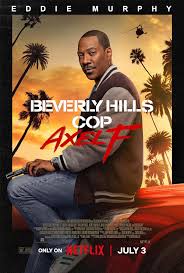
BEVERLEY HILL COP-AXEL F
US, 2024, 118 minutes, Colour.
Eddie Murphy, Joseph Gordon-Levitt, Taylour Paige, Judge Reinhold, John Ashton, Paul Reiser, Bronson Pinchot, Kevin Bacon.
Directed by Mark Molloy.
Older moviegoers remember and realise that they first met a young 20 something Eddie Murphy as Detroit Cop operating in Los Angeles, Beverly Hills, Axel Foley, and the first Beverley Hills Cop, 1984. There was a sequel. And the third film was released, in fact, 20 years ago, 1994. Could the franchise be resurrected after 20 years? What is the status of Eddie Murphy and film roles by 2024?
The quick answer is that the older fans are very happy to see Axel Foley again, enjoyed Eddie Murphy screen presence, his grin, brashness, ability to take on major criminals. So, it looks as if he will be welcomed by the younger film fans.
In many of the comments, the word nostalgia is used. The first film was such a hit and Eddie Murphy went on to make such engaging films as 48 Hours, Trading Places, Coming to America… As well as having a very successful career with such franchises as Dr Dolittle and the Nutty Professor. But, in more recent times collapse in popularity but a revival within the last 10 years on screen in cinemas and television.
Watching this film, we would think we were back 30 years, Eddie Murphy just the same, absolutely self-confident, grinning and laughing, wisecracks, willing to take on the world, crusading against the criminals. And, for nostalgia so, three characters from the original films return, the police chief played by John Ashton, the partner played by Judge Reinhold, the eccentric manager played by Bronson Pinchot.
But, this time there is Axel Foley’s daughter, estranged from her father, a lawyer in Los Angeles, taking on a client who has been framed by powerful drug dealers, even pushed from a top story garage and her car dangling high above the street. And Axel gets a phone call from Rosewood, Judge Reinhold, which sets him on the course for Beverly Hills, reconciling with his daughter, getting the criminals – headed by a rather sinister -looking and smug-sounding Kevin Bacon.
But, action sequences were the mark of the previous films and, of course, here they are. A robbery is going on at the ice hockey stadium, leading to pursuit, an elaborate car chase, motorbikes, a huge grader and the smashing of cars galore (which, while spectacular, does seem too much of a bad thing). And there will be chases naturally in Los Angeles. And quite a turn with a helicopter falling down, along the streets, a golf course.
In Beverly Hills, Axel makes such an entry, going to Rosewood’s apartment to find him, thugs ransacking the apartment, pursuit and subsequent arrest. Contacting his daughter, Jane (Taylour Paige) who does not want anything to do with him. And there is also her former boyfriend in the Department played by Joseph Gordon-Levitt. And his old boss, Taggart, John Ashton.
Not difficult to see where the plot developments will go – confrontations with the smarmy Kevin Bacon, his thugs, thwarting drug deals, rescuing Rosewood, and all the time the ups and downs with his daughter.
Which means then that this Axel Foley outing is what audiences were expecting, hoping for – and, most seem to be happy with the outcome. And another one?
Life’s Healing Journey – St Mary’s Towers and beyond
Life’s Healing Journey – St Mary’s Towers and beyond

Ed Travers, msc, has been gifting the Life’s Healing Journey retreat to the men of the Seminary of the Good Shepherd for many years. This year Ed was supported in facilitating the retreat by the seminary Spiritual Director, Fr John Armstrong, Fr Manuel Garcia from the Sydney Archdiocese, Dominic Gleeson, MSC, Peter Harvey-Jackson, MSC and Sr Jenny Scally, RSJ.
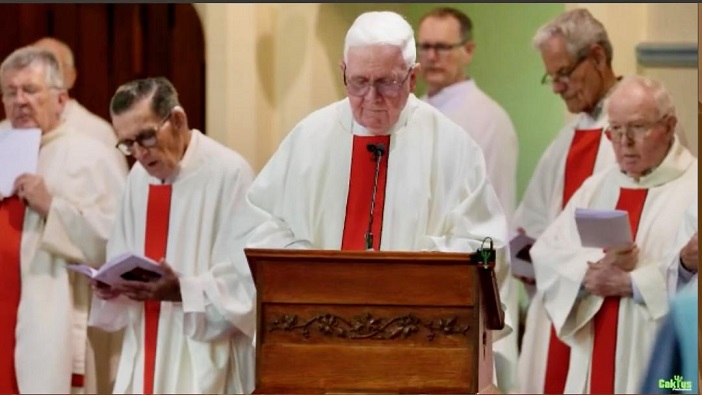
There were eight men from the seminary undertaking the retreat this year representing a number of different dioceses throughout Australia. Peter Hendriks, MSC, Krish Mathavan, MSC prayed this retreat and Long Tran and Nang Vu, our own men of the MSC Novitiate also undertook the retreat. There are a number of men from various dioceses around Australia who preparing for Diaconate or for ordination to Priesthood who participated in the retreat here at the Towers as well.
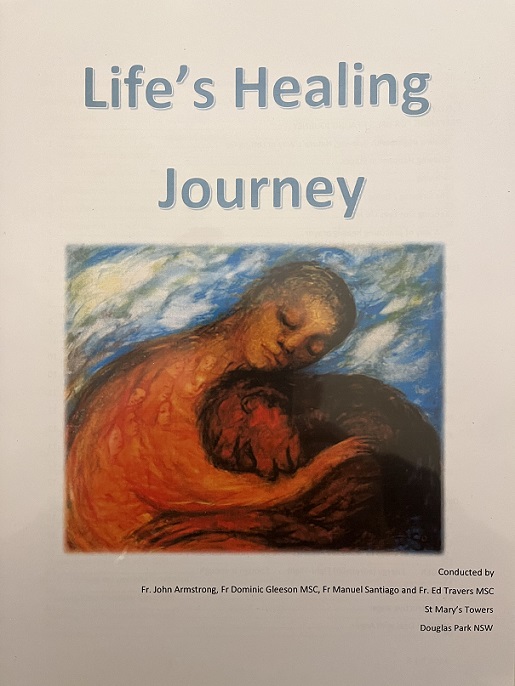
Life’s Healing Journey was established by our US confrere, Peter Campbell MSC who died some years ago.
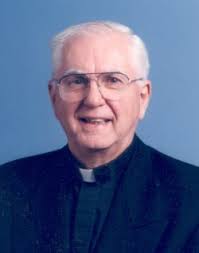
The MSC Life’s Healing Journey retreat has become a recognised and vital complement to the seminary’s spirituality program. It is providing a valuable resource for the men who undertake the retreat to continually reflect on their lives as a consequence of the Life’s Healing Journey that they embark on early in their preparation for Priesthood.

Over recent years Dominic has been leading retreats in Fiji and India for MSC confreres.
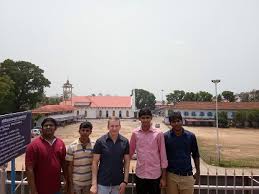
The Chevalier Family Australia supports NAIDOC week
The Chevalier Family Australia supports NAIDOC week

– we have a history with the people of the Northern Territory and the Torres Strait Islands for over a hundred years, MSC Brothers and Priests, OLSH Sisters, Lay Missionaries.
Our main current connection is Wadeye.

Memory of Deacon Boniface. Leo Wearden, current PP.
Held across the country from 7-14 July 2024, NAIDOC Week will celebrate and recognise the history, culture and achievements of Aboriginal and Torres Strait Islander peoples.
This year’s theme chosen by the National NAIDOC Committee, is Keep the Fire Burning! Blak, Loud & Proud.

The theme honours the enduring strength and vitality of First Nations culture – with fire a symbol of connection to Country, to each other, and to the rich tapestry of traditions that define Aboriginal and Torres Strait Islander peoples.
Within the Church, we also observe Aboriginal and Torres Strait Islander Sunday (July 7).
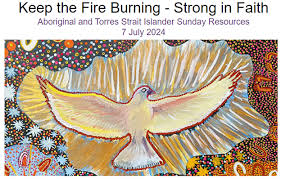
This day provides an opportunity for Catholic communities to celebrate the rich cultural heritage and spiritual traditions of Aboriginal and Torres Strait Islander peoples. It encourages congregations to reflect on the contributions and resilience of Indigenous communities and to pray for their well-being and advancement. This observance underscores the importance of integrating Indigenous perspectives and voices within the fabric of the Church’s life and mission.

Port Keats early days of the mission
The importance of reconciliation in Australia is profound, aiming to repair and strengthen the relationship between Indigenous and non-Indigenous Australians. Reconciliation involves acknowledging past injustices, addressing current inequalities, and fostering mutual respect and understanding. It is essential for creating a cohesive society where the rights, cultures, and histories of Aboriginal and Torres Strait Islander peoples are recognized and valued. Efforts toward reconciliation are not only about addressing historical wrongs but also about ensuring equitable opportunities and outcomes for Indigenous Australians in all aspects of life.
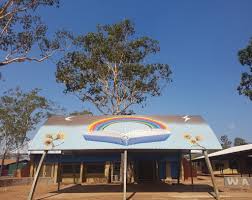
OLSH Thamarrurr Colege, Wadeye
For the Catholic Church in Australia, reconciliation is deeply tied to its mission of social justice and inclusivity. The 2023-2024 Social Justice Statement “Listen, Learn, Love: A New Engagement with Aboriginal and Torres Strait Islander Peoples” outlined the significant part the Church has to play in the reconciliation process through advocating for the rights and dignity of Aboriginal and Torres Strait Islander peoples.
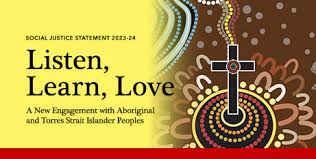
This includes supporting initiatives that promote healing, cultural preservation, and empowerment. By embracing reconciliation, the Church can contribute to a more just and compassionate society, aligning its actions with the principles of love, respect, and solidarity that are central to its teachings.
Some Significant July Days for the Chevalier Family, 2024
Some Significant July Days for the Chevalier Family, 2024
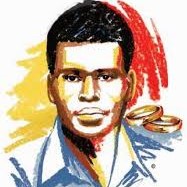
July seems to have been a mission establishing month: MSC in Yule Island, PNG; MSC in Bangalore, India; MSC in Canada; MSC Sisters in Peru.
It is also a month of memories of murdered MSCs, in Indonesia during World War II, of Peter To Rot in New Britain and in Central America of Faustino Villneuva.
1 July, 1885
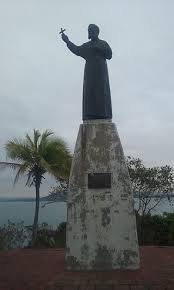
Father Verjus, Brothers Salvator Gasbarra and Nicolaus Marconi arrive in Yule Island. The mission in Papua begins!!
1 July, 1920
Father Linckens returns to Rome from Sydney where he has been since 1914 because of the war.
1 July, 1948
The first Belgian MSC team arrives in Rio de Janeiro to start a new MSC region in Brazil.
2 July, 1985
Opening of the first MSC House in India. the original house was rented from the Holy Cross Fathers, in Bangalore.
2 July, 1970

Fr. Des Moore appointed second Bishop of Sideia, consecrated in Port Moresby.
3 July, 1986
Fr. Ted Collins consecrated Bishop of Darwin in Darwin.
4 July, 1885
Fr Verjus celebrates the first Eucharist on Yule Island and 48 years later in 1933 Monsignor de Boismenu consecrates a chapel built on the site of the first Eucharist.
5 July, 1941

Unveiling of the statue of Our Lady of the Sacred Heart, Miribel, France. The statue is 33 meters high!
5 July, 1957
Erection of Kavieng (PNG) as a distinct Vicariate, entrusted to the province of the USA. Bishop Alfred Stemper is the first Vicar Apostolic.
7 July, 1945

The death of Peter To Rot, Martyr and Catechist in PNG. He was beatified, 17 December, 1995.
10 July, 1980
Father Faustino Villanueva, MSC, from the Spanish MSC Province, is assassinated in Joyabaj, Guatemala.
11 July, 1946
The body of Marie Louise Hartzer is transferred from Thuin, Belgium to the Mother House of the Daughters of Our Lady of the Sacred Heart in Issoudun.
11 July, 1966
The Apostolic Vicariate of the Gilbert Islands (Kiribati) becomes the Diocese of Tarawa. Bishop Pierre Guichet as its first Bishop.
13 July, 1878
The church of St James, Via della Sapienza, Rome, is sold by auction to the Missionaries of the Sacred Heart.
13 July, 1881
Pope Leo the 13th blesses the banner of the Sacred Heart for the mission of Melanesia and Micronesia.
14 July, 1859
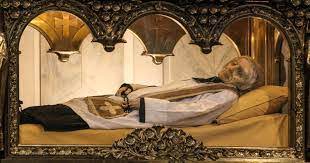
Father Jules Chevalier visits the Curé d'Ars, Jean-Marie Vianney. The Curé confirms Chevalier in his mission as founder! Two days after their visit, Father Chevalier and Piperon start a novena with the Curé d'Ars, who died shortly after on 4 August, 1859.
14 July, 1865
The Abbe Jean Vandel visits Issoudun for the first time.
14 July, 1950
Erection of the MSC region in Japan, entrusted to the Australian province
16 July, 1859
Frs Chevalier and Piperon start a novena together with the Cure d’Ars who died shortly after, on August 4.
16 July, 1959
The Vicariate of Port Moresby is divided into the Vicariate of Yule Island, entrusted to the French MSC province, and the Vicariate of Port Moresby, entrusted to the Australian MSC province.
17 July, 1874
The church in Issoudun is erected as a Minor Basilica: the Basilica of Our Lady of the Sacred Heart.
17 July, 1902
Mission Cross Ceremony for the first 12 MSC sisters, Mission House, Hiltrup, Germany.
18 July, 1900
The General Council decides to open the first MSC House in Canada, at Québec, for the French scholastics who would otherwise have to do military service for three years.
19 July, 1876
Father Chevalier buries his mother in Richelieu.
19 July, 1947
The first missionary group of MSC Sisters leave Germany to begin a mission in Peru.
20 July, 1874
Decree of approbation of the MSC Institute.
20 July, 1926

Monsignor Couppé, MSC, founder of the Daughters of Mary Immaculate, a local congregation in Papua New Guinea, dies at Douglas Park in Australia.
21 July, 1873
The MSC General Council decides to send Fr. Chapell to Toronto
21 July, 1896
Fr. H. Linckens, MSC, is appointed Provincial of the newly-erected German MSC Province.
21 July, 1982
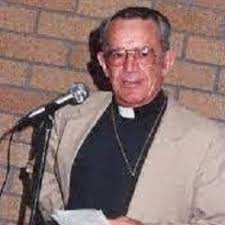
Father Eugene Cuskelly, MSC, former Superior General, is ordained auxiliary bishop of Brisbane, in Australia.
22 July, 1939
Canonical erection of the Canadian MSC province and of the MSC province of the United States.
22 July, 1970
Erection of Switzerland as MSC Section.
22 July, 1970
Pinheiro, Brazil, entrusted to the Italian MSC since 1946, is erected as a Section.
24 July, 1828
Jean Charles Piperon, one of Father Chevalier's faithful founding companions, was born about 50 kilometres from Issoudun, at Vierzon, France.
24 July, 1891
Decree of the definitive approbation of the MSC Constitutions
25 July, 1947
Fr Herman Vermeiren MSC appointed Vicar Apostolic of Coquilhatville, Zaire, ordained Bishop.
25 July, 1952
Erection of the Irish province.
26 July, 1921
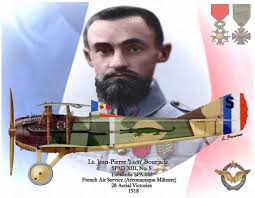
Leon Bourjade MSC, French aviation hero, is ordained priest.
26 July, 1946
The first team of MSC missionaries from the US depart to PNG to help rebuild the mission severely damaged during World War II.
28 July, 1897
Erection of the Apostolic Vicariate of the Gilbert Islands (Kiribati) distinct from the Apostolic Vicariate of Micronesia, entrusted to the MSC since 1881. Msgr Leray MSC is the first Apostolic Vicar.
29 July, 1902
Departure of the first five MSC sisters from Germany for the Marshall Islands.
30 July, 1942
Monsignor Aerts and 12 Dutch MSC confreres are killed at Langgur, Indonesia, during World War II.
31 July, 1873
Father J.B. Chappel and Brother H. Dechâtre leave France for the very first MSC overseas mission: the mission in Canada! In 1875, they establish the first MSC residence in the USA, at Watertown, New York State. Former MSC Superior General, (2005-2017), Father Mark McDonald, MSC, was born and grew up in Watertown!
31 July, 1878
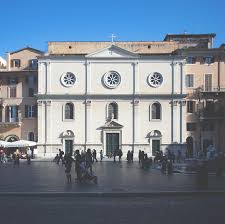
Father Chevalier signs the purchase deed of the Church of St James of the Spaniards, Piazza Navona, Rome. Today it is known as the Church of Our Lady of the Sacred Heart.
The Chevalier Family First Friday Program, 2024, July
The Chevalier Family First Friday Program, 2024, July
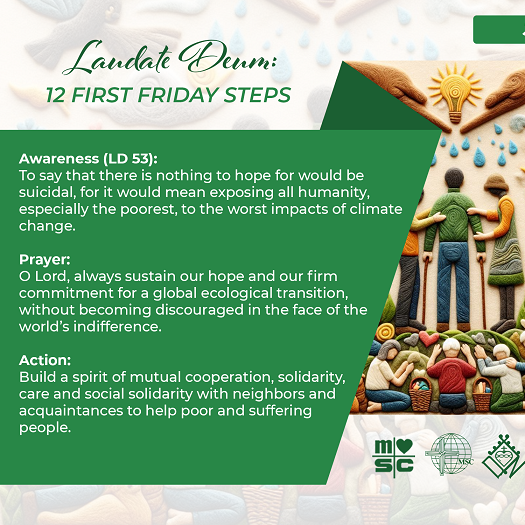
The poster for July
And a supplementary good thought and challenge

Next Sunday, July 7th, Remembering Blessed Peter To Rot
Next Sunday, July 7th, Remembering Blessed Peter To Rot
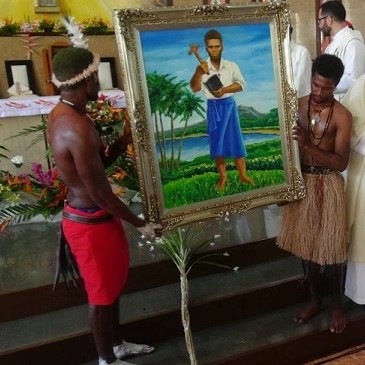
If you would like to know more about Peter to Rot, there is a great deal on him our our website. Go to News, the Current News. Where it indicates to type in the inquiry, put Peter to Rot and click enter. Some entries are repeats of Significant Days but there are three pages of references.
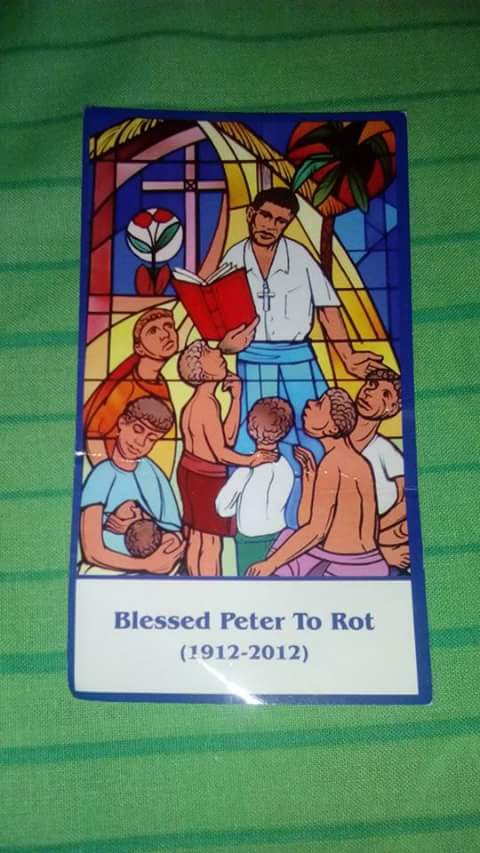
Archbishop Rochus Tatamai MSC – and a personal, family memory
Archbishop Rochus Tatamai is a close relative of Blessed Peter To Rot.
Peter To Rot's elder brother is Joseph Tatamai, who is the Archbishop’s
grandfather. Joseph Tatamai is the father of Rochus Tatamai, and Archbishop
took both names: his father and his grandfather’s name, and thus he was
baptised Rochus Joseph Tatamai. Since Blessed Peter To Rot was the younger
brother of his grandfather, according to Melanesian culture and traditions,
Peter To Rot is considered also his grandfather.


A privileged anecdote
I still fondly recall the deep, strong voice of St John Paul II on 17th January 1995 at the Nunciature after the Solemnity of the Beatification of Peter ToRot as "BLESSED" at Sir John Guise Stadium. when Yours Truly had a sneaked in opportunity to present and introduce the three cousins (JOHN TOKELETO. ROCHUS TIRUPIA AND RUFINA IAMAMA) to the then His Holiness POPE JOHN PAUL II.
When presenting RUFINA IAMAMA to his Holiness. The Pope held my hand firmly and asked me these simple and yet pleasant familiar words...IS SHE YOUR AUNT??? IS SHE A GOOD AUNT???At this instant. YOURS TRULY CAN NEVER GET OVER THE FACT THAT I SHOOK HANDS WITH A HOLY MAN.
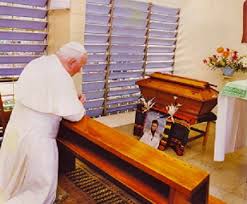
HE IS NOW SAINT POPE JOHN PAUL II. MAY I SNEAK IN ANOTHER SMALL DETAIL TO ADD I WAS PRIVILEGED TO HAVE SHOOK HANDS WITH SAINT POPE JOHN PAUL II ON BOTH HIS PASTORAL VISITS TO PNG -IN 1984 AND IN1995. (@ SIR HUBERT MURRAY STADIUM 1984 THEN @ THE SIR JOHN GUISE STADIUM 1995)
6th July 2011

